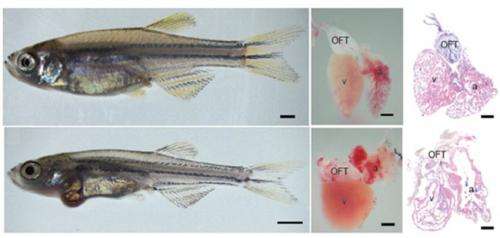Zebrafish model helps identify compound that reverses a lethal form of cardiomyopathy

Using a zebrafish model, investigators have identified a drug compound that appears to reverse arrhythmogenic cardiomyopathy (ACM), a hereditary disease and leading cause of sudden death in young people. The findings, led by investigators at Beth Israel Deaconess Medical Center (BIDMC) and Brigham and Women's Hospital, provide a key first step in developing new therapies for this dangerous condition, for which there is currently no preventive treatment.
The study appears in the June 11 issue of Science Translational Medicine.
"For some individuals, ACM has no symptoms or warning signs, meaning that the first and only manifestation of disease is sudden death," explains corresponding author Jeffrey E. Saffitz, MD, PhD, Chairman of the Department of Pathology at BIDMC and Mallinckrodt Professor of Pathology at Harvard Medical School. The condition affects approximately 1 in 5,000 individuals worldwide, often striking patients under age 35.
ACM damages the muscle of the heart's ventricles (the pumping chambers) so that, over time, muscle cells or myocytes, become replaced by fatty deposits and fibrosis, leaving patients especially susceptible to arrhythmias. Once an arrhythmia develops, the heartbeat becomes rapid and erratic causing the victim to grow dizzy or collapse – and in the most serious cases to suffer sudden cardiac death.
"There are currently no drugs available that can reliably prevent arrhythmias and sudden death in ACM," explains Saffitz. Patients who exhibit frequent arrhythmias or experience repeated fainting spells are considered to be at risk for sudden death, and often undergo implantation of an automatic cardiac defibrillator (ICD) which continuously monitors the heart rhythm and delivers a shock to the heart if it detects a potentially lethal rhythm abnormality.
"While ICDs can be life-saving, they are expensive and can create a serious psychological burden for the patient," adds Saffitz. "Waiting for a life-threatening arrhythmia to develop and then relying on a device to stop it by delivering a painful shock is not the ideal way to manage this condition. We have to find drugs that can prevent the arrhythmia from occurring in the first place."
To identify the mechanisms underlying this dangerous disease and to find potential drugs to prevent its onset, co-senior author Calum A. MacRae, MD, PhD, a geneticist in the Division of Cardiovascular Medicine at Brigham and Women's Hospital created a screenable zebrafish model of ACM with cardiac myocyte-specific expression of a human mutation in the gene encoding plakoglobin, which is known to cause ACM in humans. By working with zebrafish, which develop rapidly and can be produced in large quantities, the investigators could see clear evidence of heart disease after only 48 hours of embryonic development.
They then conducted a high-throughput screen to test 4,800 chemicals to identify a suppressor of the disease phenotype. One chemical in particular, SB216763, showed a remarkable ability to prevent or reverse the disease in fish. Armed with this new information, the investigators confirmed their findings through studies of both mammalian models of ACM and human heart muscle cells derived from adult stem cells from ACM patients.
"We found that a single small molecule [SB216763] could reverse both the muscle cell injury and the arrhythmia components of ACM," says Saffitz. These new findings provide strong evidence that these complex disease processes are linked to a common mechanism, which appears to involve a defect in forward trafficking of key proteins to the intercalated disc, sites of cell-cell adhesion.
"It also appears that we have discovered a new mechanism-based anti-arrhythmic drug that can prevent or reverse major abnormalities of cellular electrophysiology in the heart in cases of ACM," says Saffitz. "This work shows that it is possible to model a complex human disease in fish and use high-throughput screens of large chemical libraries for the discovery of effective new drugs and could help provide the foundation for future chemical biology efforts to bring such drugs to clinical use."
More information: "Identification of a New Modulator of the Intercalated Disc in a Zebrafish Model of Arrhythmogenic Cardiomyopathy," by A. Asimaki et al. Science Translational Medicine, 2014. stm.sciencemag.org/lookup/doi/ … scitranslmed.3008008
















